Optimizing Bottleneck Flow and Enhancing Throughput in Prosthodontic Services Using Additive Manufacturing with Discrete Event Simulation and Central Composite Design †
Abstract
:1. Introduction
2. Methodology
2.1. Nomenclature
2.2. Work Design
2.3. Base Model
2.3.1. Model Assumptions
- The time required for each service at Servers A to F is constant or follows a known distribution.
- Staff members are always available at their respective servers and are not interrupted by other tasks.
- Patients are processed on a first-come, first-served basis without prioritization.
- All servers and staff are fully utilized during operating hours, and there is no downtime due to equipment failure or staff breaks.
- Interaction times between staff and patients, as well as between staff members, are negligible and do not affect overall service time.
- Washroom usage doesn’t significantly impact the flow and timing.
2.3.2. Base Model Stats
2.4. Bottle Neck Identification
2.5. Alternative Model
Alternative Model Stats
3. Design of Experiments in the Alternative Model Simulation Run
Utilization of Servers and Throughput of System Versus Experimental Runs
4. Optimized Model
Comparison of Models
5. Conclusions
Author Contributions
Funding
Institutional Review Board Statement
Informed Consent Statement
Data Availability Statement
Conflicts of Interest
References
- Banks, J.; Carson, J.S.; Nelson, B.L.; Nicol, D.M. Discrete-Event System Simulation; Pearson Prentice Hall: Hoboken, NJ, USA, 2023. [Google Scholar]
- Sinha, A.; Das, S. Optimizing real-world factory flows using aggregated discrete event simulation modelling. Flex. Serv. Manuf. J. 2023, 35, 123–140. [Google Scholar]
- Kumar, R.; Gupta, R. Exploring additive manufacturing as a high-throughput screening tool in prosthodontics. Addit. Manuf. 2023, 42, 101–115. [Google Scholar]
- Zhou, X.; Lee, M. Design of Experiments in Healthcare: Applications of Central Composite Design. J. Healthc. Eng. 2023, 24, 234–250. [Google Scholar]
- Patel, B.; Singh, P. Enhancing Throughput in Prosthodontics Using Additive Manufacturing and Discrete Event Simulation. J. Prosthet. Dent. 2023, 130, 101–110. [Google Scholar]
- Abideen, A.; Mohamad, F.B. Improving the performance of a Malaysian pharmaceutical warehouse supply chain by integrating value stream mapping and discrete event simulation. J. Model. Manag. 2021, 16, 70–102. [Google Scholar] [CrossRef]
- Berleant, D. Discrete-Event Simulation in Healthcare Settings: A Review. Modelling 2022, 3, 417–433. [Google Scholar] [CrossRef]
- Intini, F.; Merla, P.; Pagliara, R.; Partipilo, M.; Stigliano, G.; Veneto, D. Discrete Event Simulation for the Analysis and Re-Engineering of Production and Logistics Cycles: The Case of Master Italy Company; Springer Nature Switzerland: Cham, Switzerland, 2021. [Google Scholar]
- Vázquez-Serrano, J.I.; Peimbert-García, R.E.; Cárdenas-Barrón, L.E. Discrete-Event Simulation Modeling in Healthcare: A Comprehensive Review. Int. J. Environ. Res. Public Health 2021, 18, 12262. [Google Scholar] [CrossRef] [PubMed]
- Omogbai, O.; Salonitis, K. Manufacturing system lean improvement design using discrete event simulation. Procedia CIRP 2021, 57, 195–200. [Google Scholar] [CrossRef]
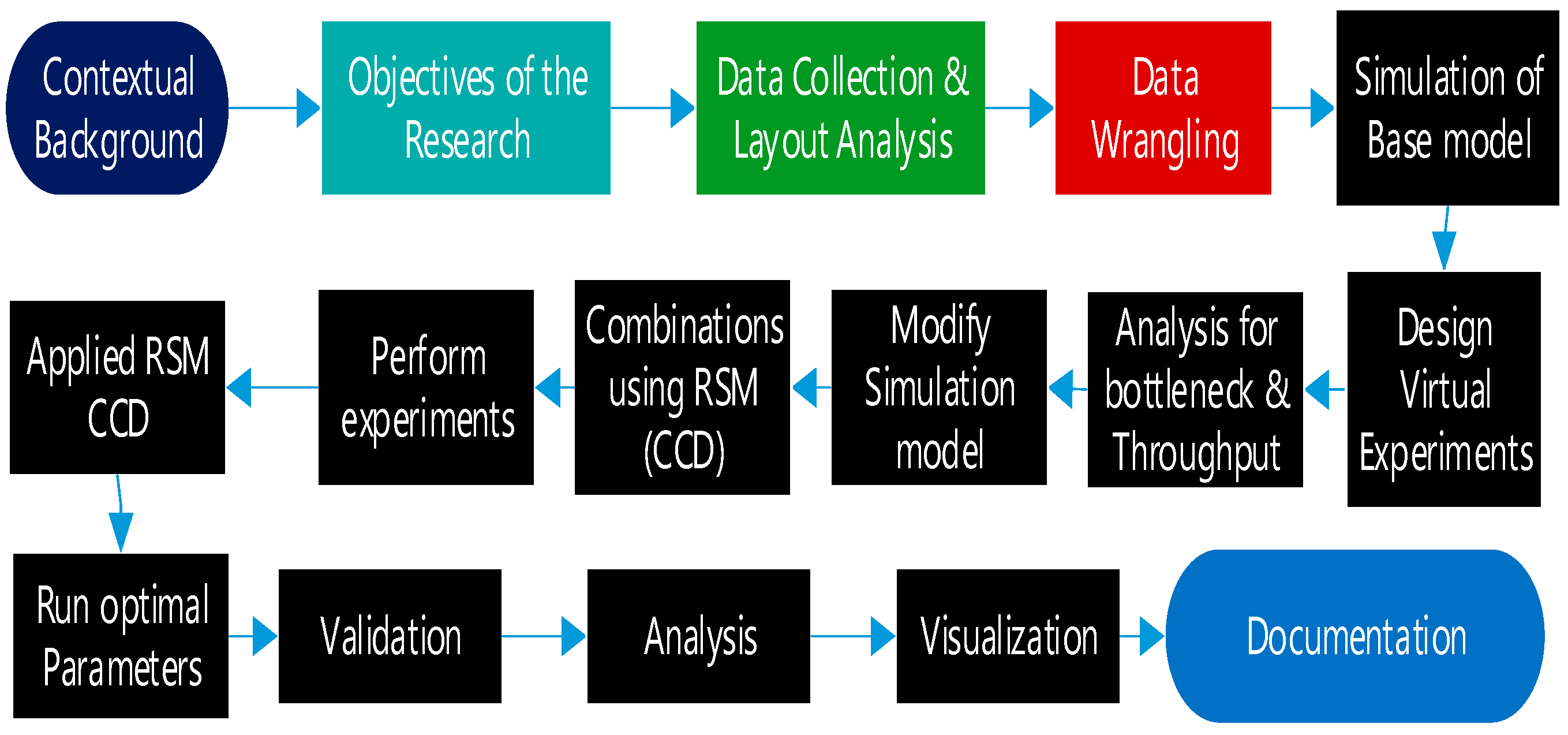
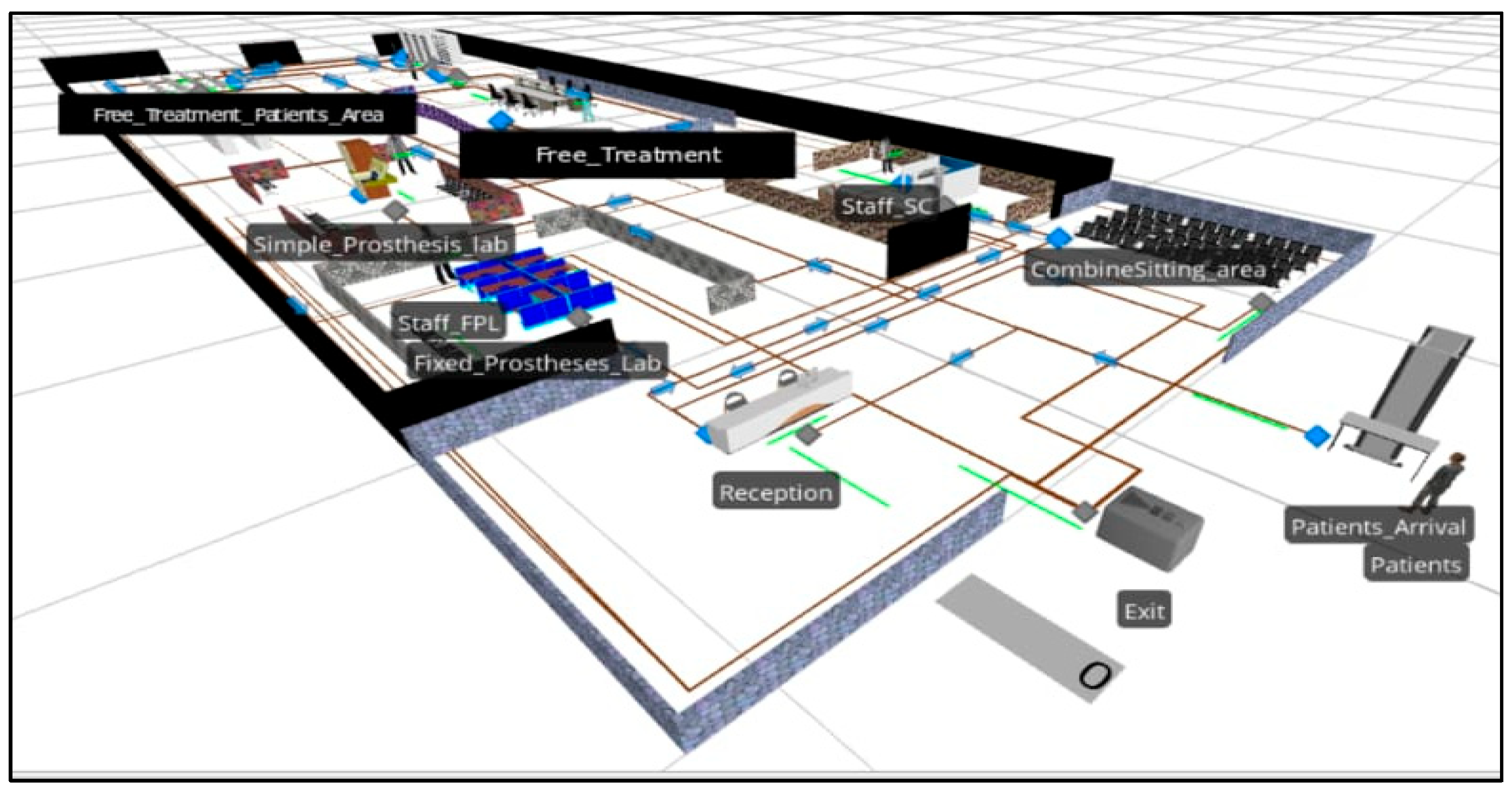
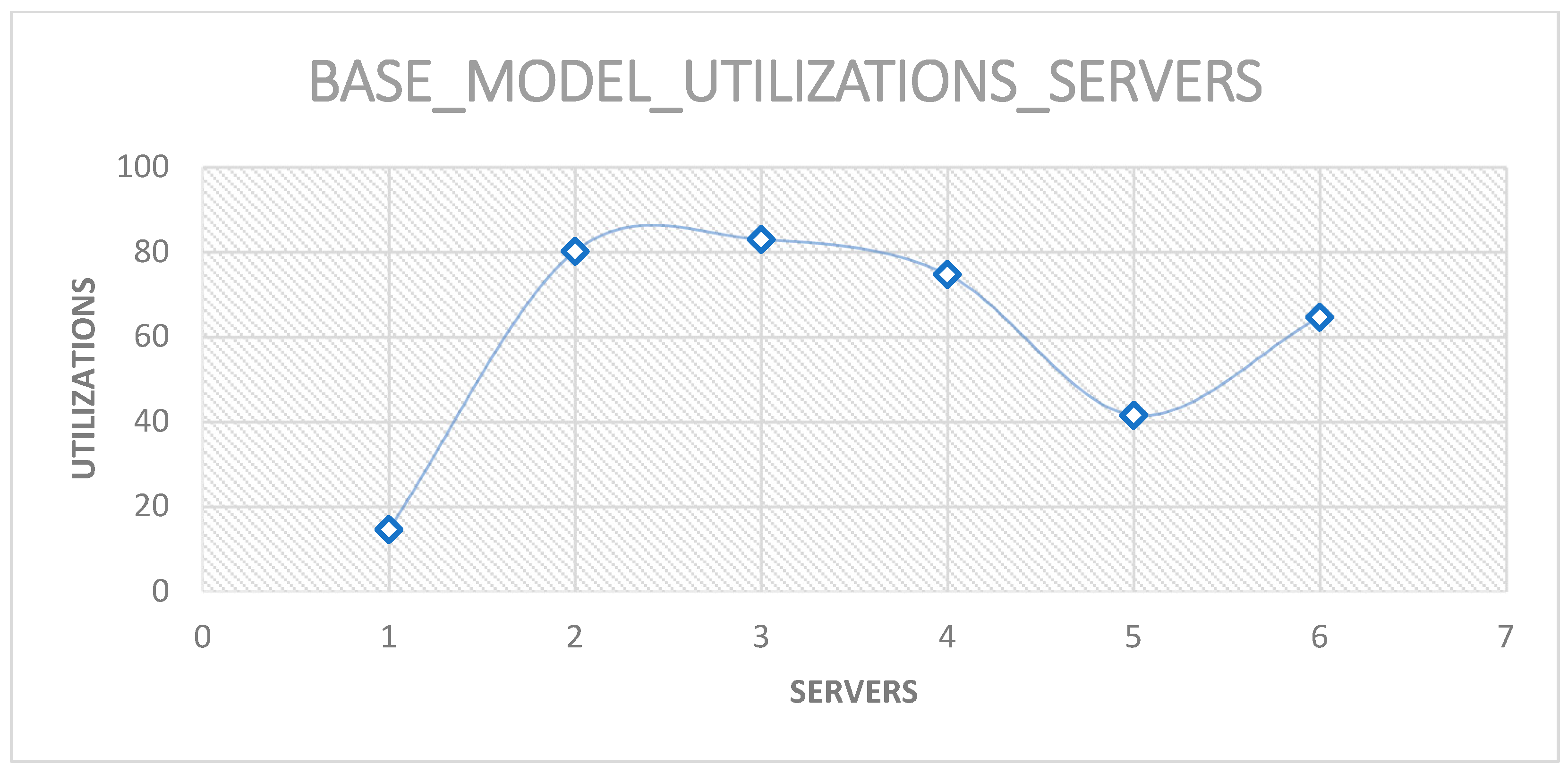
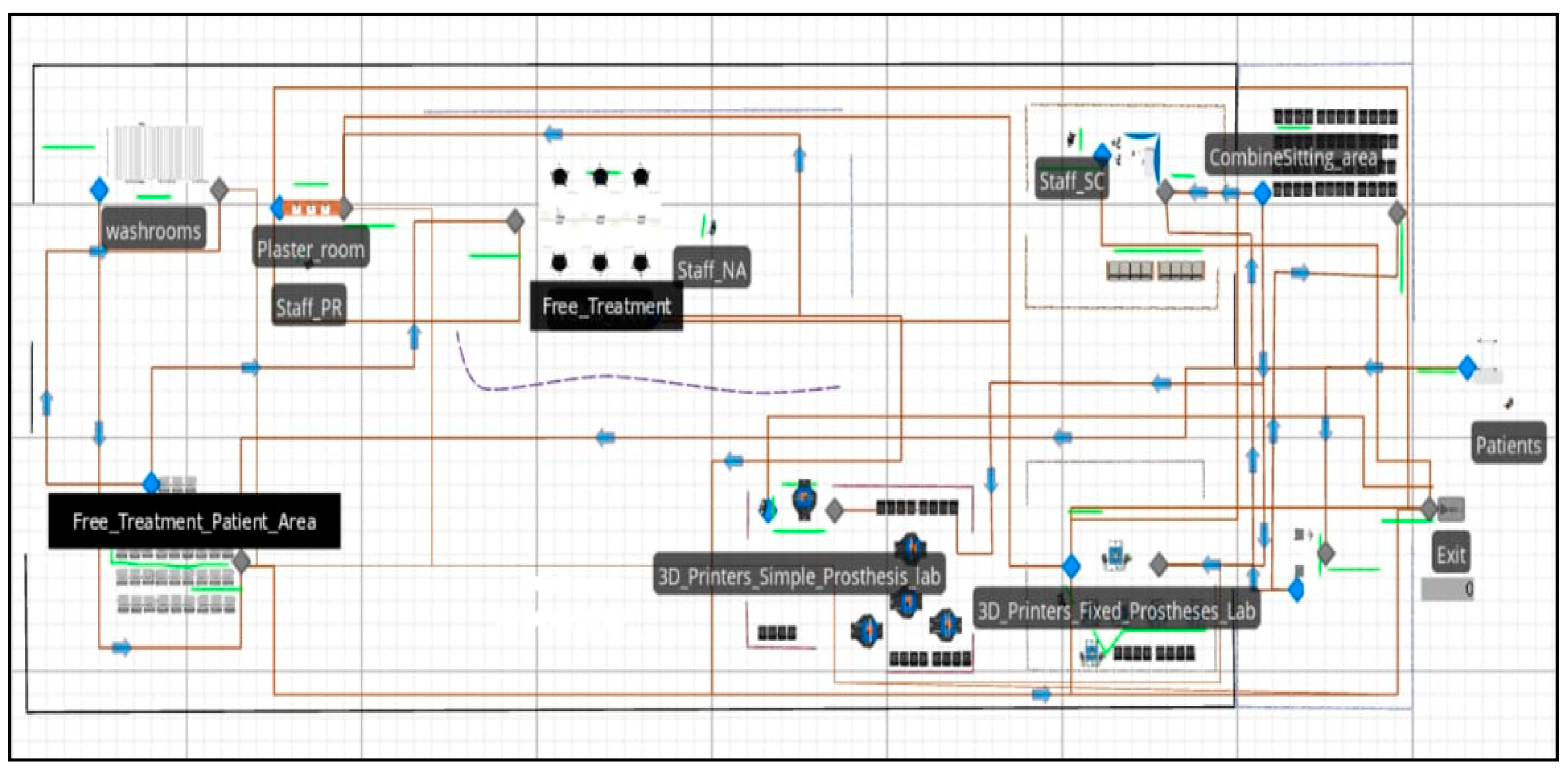
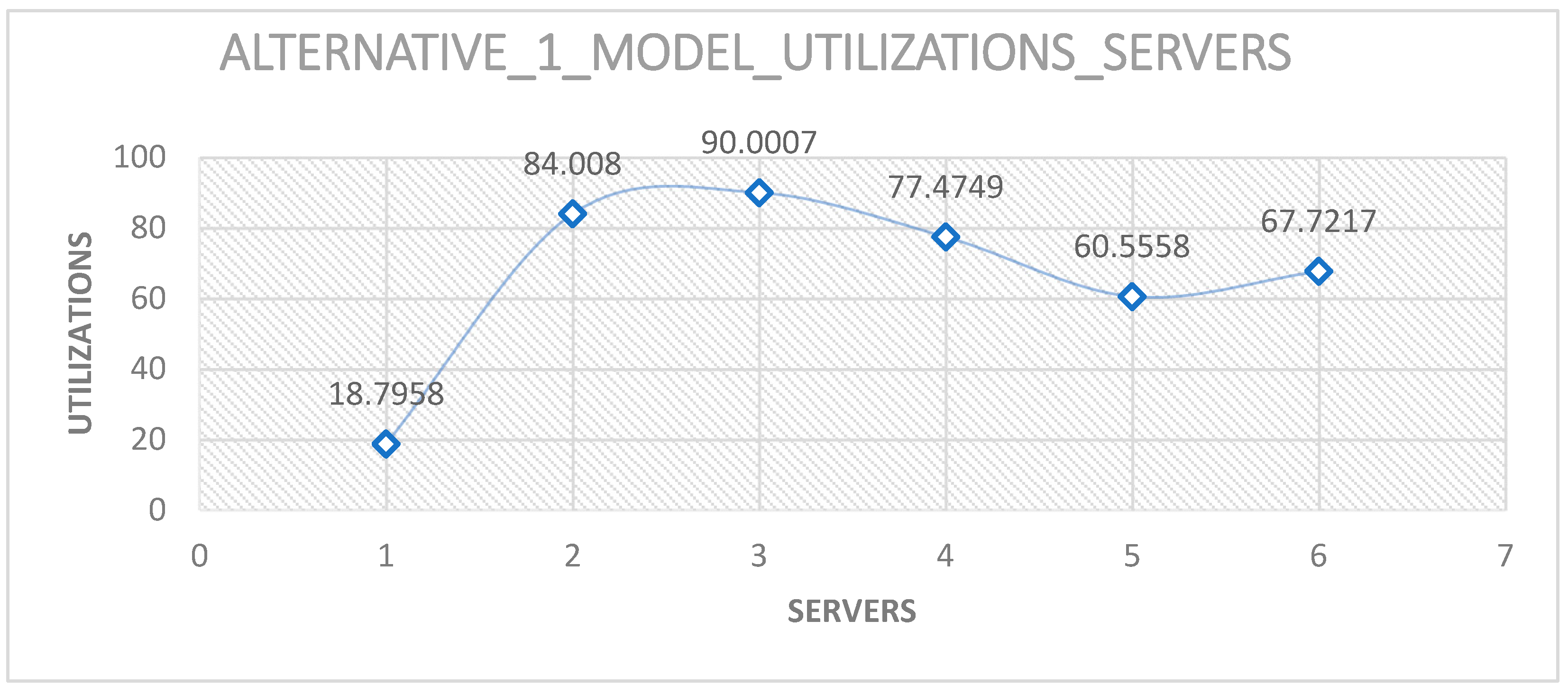
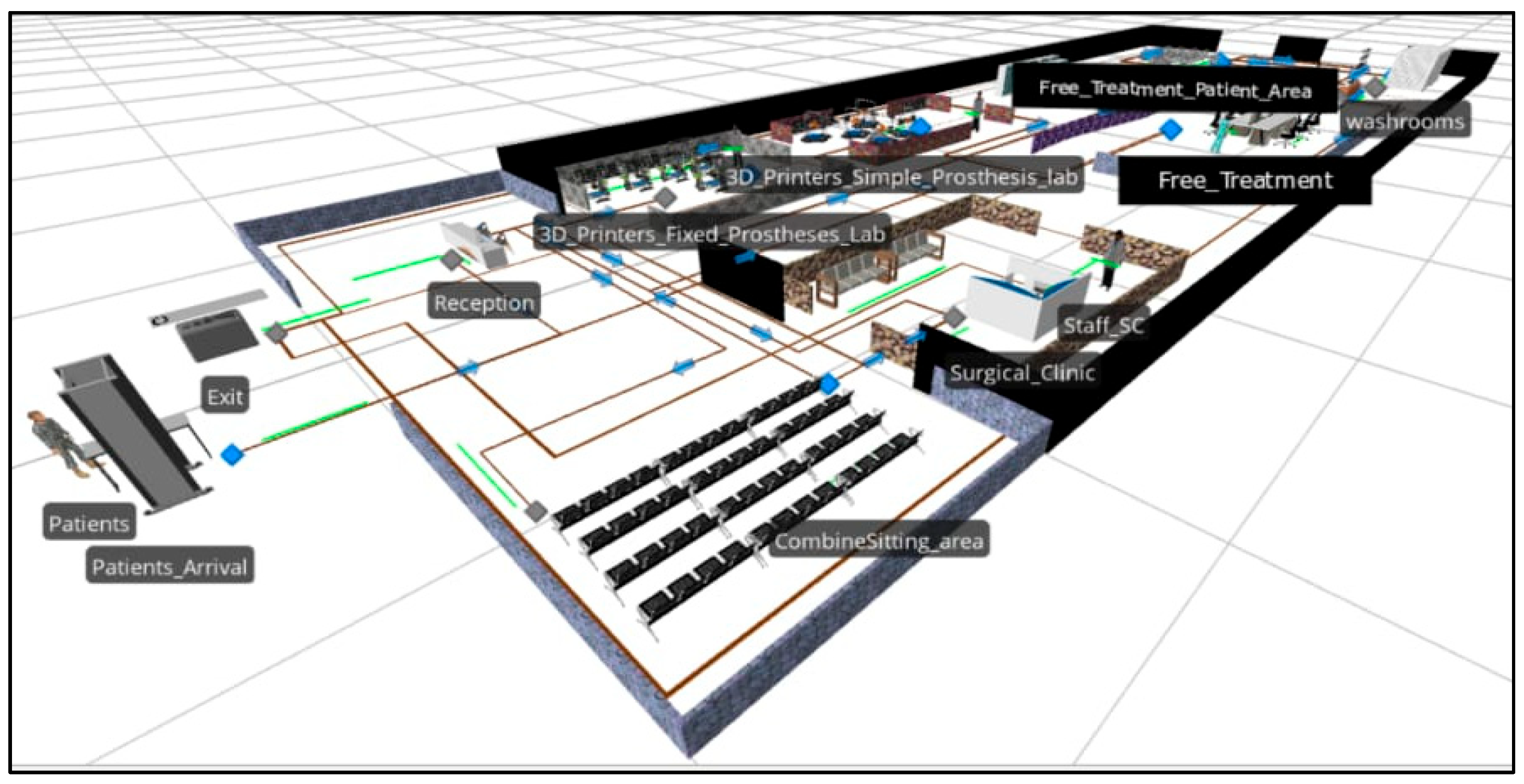



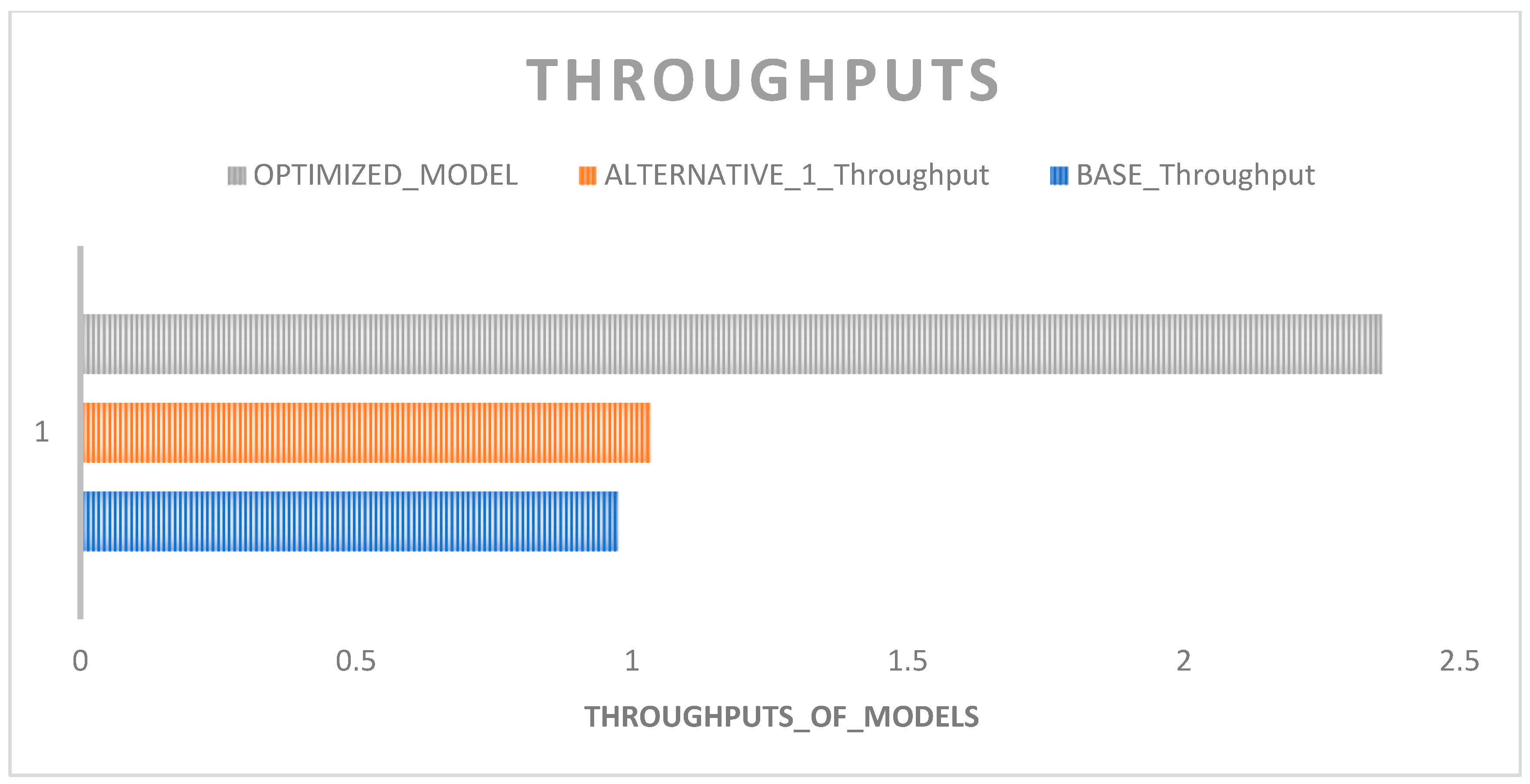
| Reception | Server 1 | 2 + WEIB(2.31, 1.24) |
| Fixed Prosthesis Lab | Server 2 | Tria(37, 46.1, 50) |
| Surgical Clinic | Server 3 | 16 + 38 * BETA(0.812, 1.1) |
| Simple Prosthesis Lab | Server 4 | 28 + GAMM(12.5, 1.31) |
| Patient Area | Server 5 | Norm(24.6, 6.01) |
| Plaster Room | Server 6 | 6 + 19 * Beta(0.834, 1.06) |
| Operators_3 | Capacity_3 | Process_2 | Capacity_2 | Process_4 | Capacity_4 |
|---|---|---|---|---|---|
| 1 | 5 | 40 | 6 | 35 | 6 |
| 2 | 5 | 40 | 6 | 35 | 10 |
| 1 | 8 | 40 | 6 | 35 | 10 |
| 2 | 8 | 40 | 6 | 35 | 6 |
| 1 | 5 | 60 | 6 | 35 | 10 |
| 2 | 5 | 60 | 6 | 35 | 6 |
| 1 | 8 | 60 | 6 | 35 | 6 |
| 2 | 8 | 60 | 6 | 35 | 10 |
| 1 | 5 | 40 | 10 | 35 | 10 |
| 2 | 5 | 40 | 10 | 35 | 6 |
| 1 | 8 | 40 | 10 | 35 | 6 |
| 2 | 8 | 40 | 10 | 35 | 10 |
| 1 | 5 | 60 | 10 | 35 | 6 |
| 2 | 5 | 60 | 10 | 35 | 10 |
| 1 | 8 | 60 | 10 | 35 | 10 |
| 2 | 8 | 60 | 10 | 35 | 6 |
| 1 | 5 | 40 | 6 | 50 | 10 |
| 2 | 5 | 40 | 6 | 50 | 6 |
| 1 | 8 | 40 | 6 | 50 | 6 |
| 2 | 8 | 40 | 6 | 50 | 10 |
| 1 | 5 | 60 | 6 | 50 | 6 |
| 2 | 5 | 60 | 6 | 50 | 10 |
| 1 | 8 | 60 | 6 | 50 | 10 |
| 2 | 8 | 60 | 6 | 50 | 6 |
| 1 | 5 | 40 | 10 | 50 | 6 |
| 2 | 5 | 40 | 10 | 50 | 10 |
| 1 | 8 | 40 | 10 | 50 | 10 |
| 2 | 8 | 40 | 10 | 50 | 6 |
| 1 | 5 | 60 | 10 | 50 | 10 |
| 2 | 5 | 60 | 10 | 50 | 6 |
| 1 | 8 | 60 | 10 | 50 | 6 |
| 2 | 8 | 60 | 10 | 50 | 10 |
| 0.3 | 6.5 | 50 | 8 | 42.5 | 8 |
| 2.6 | 6.5 | 50 | 8 | 42.5 | 8 |
| 1.5 | 2.9 | 50 | 8 | 42.5 | 8 |
| 1.5 | 10.0 | 50 | 8 | 42.5 | 8 |
| 1.5 | 6.5 | 26.2 | 8 | 42.5 | 8 |
| 1.5 | 6.5 | 73.7 | 8 | 42.5 | 8 |
| 1.5 | 6.5 | 50 | 3.2 | 42.5 | 8 |
| 1.5 | 6.5 | 50 | 12.7 | 42.5 | 8 |
| 1.5 | 6.5 | 50 | 8 | 24.6 | 8 |
| 1.5 | 6.5 | 50 | 8 | 60.3 | 8 |
| 1.5 | 6.5 | 50 | 8 | 42.5 | 3.2 |
| 1.5 | 6.5 | 50 | 8 | 42.5 | 12.7 |
| 1.5 | 6.5 | 50 | 8 | 42.5 | 8 |
| 1.5 | 6.5 | 50 | 8 | 42.5 | 8 |
| 1.5 | 6.5 | 50 | 8 | 42.5 | 8 |
| 1.5 | 6.5 | 50 | 8 | 42.5 | 8 |
| 1.5 | 6.5 | 50 | 8 | 42.5 | 8 |
| 1.5 | 6.5 | 50 | 8 | 42.5 | 8 |
| 1.5 | 6.5 | 50 | 8 | 42.5 | 8 |
| 1.5 | 6.5 | 50 | 8 | 42.5 | 8 |
| 1.5 | 6.5 | 50 | 8 | 42.5 | 8 |
| Operator 3 | Capacity 3 | Capacity 2 | Process Time 2 | Capacity 4 | Process Time 4 |
|---|---|---|---|---|---|
| 1 | 5 | 60 | 10 | 50 | 10 |
Disclaimer/Publisher’s Note: The statements, opinions and data contained in all publications are solely those of the individual author(s) and contributor(s) and not of MDPI and/or the editor(s). MDPI and/or the editor(s) disclaim responsibility for any injury to people or property resulting from any ideas, methods, instructions or products referred to in the content. |
© 2024 by the authors. Licensee MDPI, Basel, Switzerland. This article is an open access article distributed under the terms and conditions of the Creative Commons Attribution (CC BY) license (https://creativecommons.org/licenses/by/4.0/).
Share and Cite
Mukhtar, G.A.; Shehzadi, S.; Shahid, U.; Shakeel, G.; Mustafa, R.A. Optimizing Bottleneck Flow and Enhancing Throughput in Prosthodontic Services Using Additive Manufacturing with Discrete Event Simulation and Central Composite Design. Eng. Proc. 2024, 75, 9. https://doi.org/10.3390/engproc2024075009
Mukhtar GA, Shehzadi S, Shahid U, Shakeel G, Mustafa RA. Optimizing Bottleneck Flow and Enhancing Throughput in Prosthodontic Services Using Additive Manufacturing with Discrete Event Simulation and Central Composite Design. Engineering Proceedings. 2024; 75(1):9. https://doi.org/10.3390/engproc2024075009
Chicago/Turabian StyleMukhtar, Ghulam Ameer, Sana Shehzadi, Umair Shahid, Ghufran Shakeel, and Raja Asim Mustafa. 2024. "Optimizing Bottleneck Flow and Enhancing Throughput in Prosthodontic Services Using Additive Manufacturing with Discrete Event Simulation and Central Composite Design" Engineering Proceedings 75, no. 1: 9. https://doi.org/10.3390/engproc2024075009






